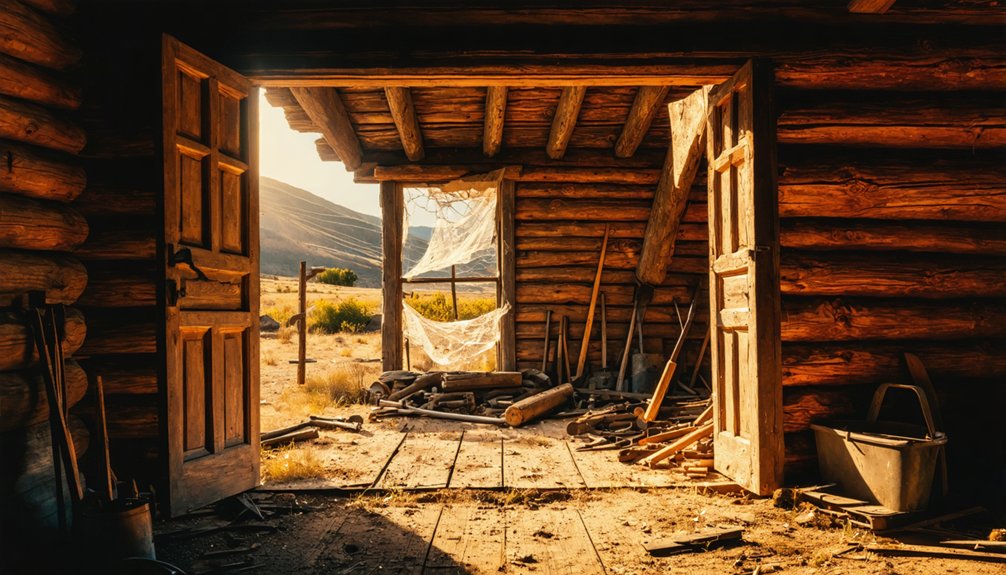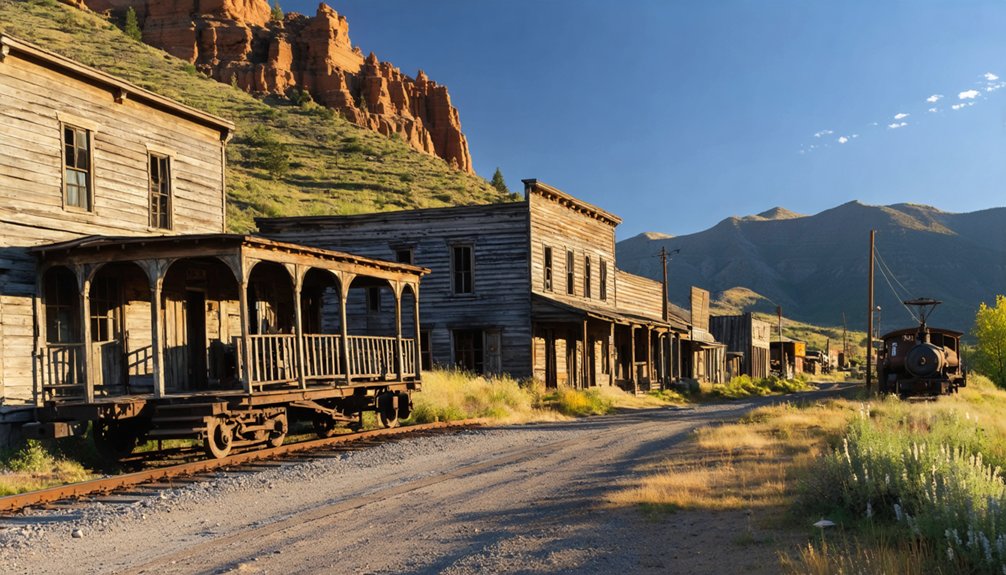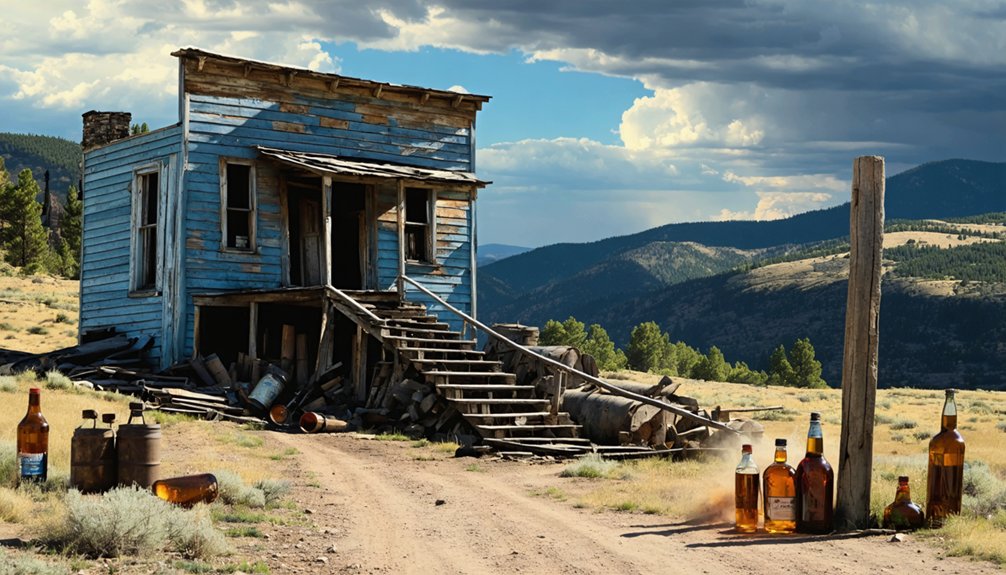You’ll find Brodhead in Las Animas County, Colorado—a coal mining ghost town established by the Brodhead brothers around 1900. Once home to 300 residents whose lives revolved around the dangerous Brodhead #3 mine, the town operated under strict company control with worker housing and essential services. When mines closed in the 1920s, the community collapsed, leaving only foundations and mining artifacts today. The scattered remains tell a deeper story of Colorado’s industrial past.
Key Takeaways
- Brodhead was a coal mining company town established by the Brodhead brothers who recognized valuable coal deposits in the area.
- The town operated during two main periods (1900-1911 and 1917-1919) with approximately 300 residents at its peak.
- Miners faced dangerous working conditions while the company maintained control through housing, company stores, and wage deductions.
- Mine closures in the 1920s triggered economic collapse, causing population shifts as residents sought employment elsewhere.
- Today, only foundations and debris remain of Brodhead, serving as reminders of Colorado’s coal mining heritage.
The Brodhead Brothers: Founders of a Mining Empire
Three ambitious siblings—Henry C., Albert G., and Robert S. Brodhead established a formidable coal mining enterprise in the Colorado frontier, creating both a business and a community bearing their name.
The brothers wholly owned and operated their mining venture, continuing a Brodhead legacy of pioneering leadership that stretched back to Revolutionary War captain Luke Brodhead.
Their mining entrepreneurship transformed an undeveloped area into a functioning company town designed specifically for coal extraction.
Coming from a family experienced in frontier settlements and defense, the Brodheads applied this heritage to industrial development in regions that often reached high elevations like those found throughout Colorado’s mining districts.
Their operation controlled not just the mines but the entire town infrastructure, exemplifying the paternalistic business model common in isolated mining communities.
This venture represented their family’s evolution from military leadership to industrial pioneers.
Daily Life in a Company-Owned Coal Town
While the Brodhead brothers built their industrial vision, the approximately 300 residents who called Brodhead home by 1911 lived a reality common to company towns of the era.
You’d find yourself renting basic, tightly-packed housing from the Las Animas Coal Company, which also controlled the general store where you’d purchase necessities.
Your daily routine would revolve around the mine’s schedule, with about 200 men working dangerous shifts using electric equipment. Many miners drew strength from ancestral mining traditions, following in the footsteps of fathers and grandfathers who had worked in mines before them.
Community gatherings at the saloon or boarding house offered brief respites from isolation, as the town lacked direct rail access, relying on stagecoaches to reach Aguilar or Lynn.
Mining accidents loomed as constant threats, with deaths from roof collapses and electrocution recorded regularly. The town’s economic struggles mirrored Trinidad’s larger pattern of population decline due to shifting coal industry dynamics.
The company doctor and post office provided essential services in this remote outpost.
The Rise of Coal Mining in Las Animas County
Las Animas County transformed into Colorado’s coal mining powerhouse long before Brodhead appeared on the map. By 1889, seven coal mines operated in the county, each with its own post office. El Moro Mine, established in 1876, became Colorado’s largest coal and coke producer by 1889.
The industry expanded rapidly, with coal production reaching nearly 3 million tons from 35 mines by 1915. Company towns like Starkville, housing over 3,000 residents by 1900, and Cokedale, with its 350 coke ovens, emerged throughout the region. Morley Mine became particularly significant as one of the region’s largest operations, producing over 11 million tons of coal during its five decades of operation. Sopris mine, which opened in 1888, is now completely submerged under Trinidad Lake.
This industrial growth shaped the county’s labor history as CF&I and other operators built company-controlled communities around their mines.
Coal powered locomotives, fueled smelters, and built Trinidad’s business district, creating an economic boom that defined the region for generations.
Architecture and Town Layout in Brodhead
Brodhead’s architectural landscape featured utilitarian structures built primarily from wood and local materials, reflecting the transient nature of its coal mining population.
You’ll find the town was laid out in a functional pattern that prioritized access to the mines, with minimal separation between residential and industrial zones at its 6,919-foot elevation.
The settlement’s design embodied practicality over aesthetics, with simple worker housing and basic community buildings arranged to serve the mining operations that defined Brodhead’s purpose. Similar to the Silica Brick Company town, Brodhead included essential community facilities that supported daily life for workers and their families. It’s important to note that Brodhead should not be confused with similar-sounding locations, as term disambiguation helps clarify its unique identity among various places sharing this name.
Brodhead’s Structural Design
The structural design of Brodhead reflected the practical needs of a late 19th-century coal mining settlement, with function consistently prioritized over form.
You’ll notice architectural influences from the diverse immigrant populations who settled there, creating a vernacular style that defined mining town aesthetics of the era.
Buildings primarily utilized wood and brick construction, with some featuring distinctive white brick likely sourced from nearby industrial operations.
Residential structures maintained modest profiles—typically one or two stories—clustered closely together to foster community bonds.
The commercial district featured utilitarian false-front designs along a central thoroughfare, creating a hub for daily life.
The town’s grid layout maximized efficiency, with streets purposefully arranged to facilitate movement between homes, businesses, and mine entrances.
Today, only foundations and scattered debris remain to tell Brodhead’s architectural story.
Mine-Centered Community Layout
While strategically positioning itself around coal extraction operations, Brodhead exemplified the quintessential mine-centered community layout of late 19th-century resource towns.
Located 2.25 miles north of Aguilar at 6,919 feet elevation, the town’s spatial efficiency was evident in its linear arrangement of structures along pragmatic, topography-following pathways.
You’d find worker housing—occupied by Mexican and European immigrants, including miners from Stafford, England—clustered near mine entrances, fostering community interaction despite likely ethnic segregation.
Rail lines dictated much of the town’s configuration, ensuring efficient coal transportation while minimizing logistical challenges.
Social spaces remained minimal but accessible, with essential services integrated directly into mining zones.
The town’s entire infrastructure prioritized mining functionality over aesthetics, creating an industrial landscape where every element served the coal extraction economy.
The Economic Boom Years (1880s-1900s)

During the prosperous decades spanning from the 1880s to the 1900s, Brodhead experienced unprecedented economic growth fueled by Colorado’s broader silver boom and the burgeoning coal industry.
While primarily coal-focused, the town benefited from regional silver mining economic impact as capital flowed into Las Animas County. The Colorado Fuel and Iron Company‘s expansion into local lands accelerated development, while advancing railroad networks transformed Brodhead from isolated settlement to essential production center. Working conditions in the mines were exceptionally dangerous, with miners facing serious health risks including silicosis from continuous dust exposure. Following the devastating Ludlow Massacre in 1914, miners in Brodhead joined the statewide push for improved working conditions and safety standards.
- Coal-laden rail cars departing daily from bustling loading platforms
- Newly constructed company housing spreading across previously empty hillsides
- Miners from diverse backgrounds crowding the town’s expanding commercial district
- Technological innovations like steam-powered extraction equipment replacing earlier manual methods
This golden era established Brodhead’s economic foundation before the 1893 Sherman Act repeal triggered regional decline.
Working Conditions in the Brodhead Mines
Working in Brodhead’s mines meant facing death daily from roof collapses, gas explosions, and deadly coal dust that filled your lungs with each breath.
You’d return from your shift to company-owned housing where your movements, speech, and gatherings were carefully monitored and restricted by mine owners who maintained absolute control over the isolated coal camps. During winter months, the risk of accidents significantly increased as the dry air created what miners called explosion season.
Despite Colorado’s early mining safety laws enacted in 1883, you’d find minimal protection as a laborer until unionization efforts—often met with violent company opposition—gradually improved conditions through hard-won concessions for safer workplaces and better wages.
Dangerous Underground Environment
Beneath the surface of Brodhead, miners faced an extraordinarily perilous workplace where death lurked in nearly every corner of the mine’s labyrinthine tunnels. The Brodhead mines harbored underground hazards that threatened workers daily, from structural instabilities to invisible killers.
High volatile bituminous coal extraction released toxic gases, primarily methane, which could suffocate or explode with the slightest spark.
- Decaying timber supports groaned under crushing weight, ready to collapse without warning.
- Concealed vertical shafts waited beneath seemingly solid floors, offering fatal drops.
- Abandoned dynamite deteriorated to unstable compounds, sensitive to the slightest touch.
- Poisonous gases accumulated in poorly ventilated chambers, silently displacing breathable air.
You would’ve entered these death traps daily, trusting inadequate safety measures while extracting coal that fueled America’s industrial revolution.
Company Housing Control
As miners descended into Brodhead’s treacherous depths each day, their surface lives remained equally bound by corporate control through the company housing system.
You’d find your entire existence tethered to the coal operator—living in basic quarters near the mine entrance with rent automatically deducted from your wages.
Your home wasn’t truly yours. Company agents enforced curfews, monitored gatherings, and reported “suspicious” behavior to management.
This housing dependence created inescapable cycles of control. You’d purchase necessities at inflated prices using scrip at the company store, deepening your debt.
Immigrant families faced additional segregation by ethnicity.
The threat of eviction loomed over any whisper of unionization or dissent.
This calculated system of housing dependence guaranteed company control extended far beyond your working hours into every aspect of your life.
Limited Labor Protections
The miner’s struggle extended beyond the confines of company housing into the deadly tunnels of Brodhead’s coal mines themselves. Laborers faced daily perils without adequate protections, as pre-1938 workers lacked guarantees against excessive hours or unsafe practices.
The miners’ labor struggles often met violent opposition when they organized for safety reforms, with owners deploying armed resistance against unionization efforts.
- Roof collapses trapped men in unstable shafts, their screams echoing through cramped tunnels.
- Methane gas silently accumulated during winter’s “explosion season,” waiting for a single spark.
- Coal dust filled miners’ lungs, their blackened sputum foreshadowing early deaths.
- Child laborers descended into darkness, their small frames maneuvering tight spaces adults couldn’t reach.
Despite inspection requirements established in the 1880s, enforcement remained inconsistent, leaving workers vulnerable to the mine’s countless hazards.
The Slow Decline and Abandonment
Following the mine’s closure in the 1920s, Brodhead experienced a devastating economic collapse that triggered its gradual transformation into a ghost town.
With coal mining as virtually the only industry, residents faced immediate economic instability when operations ceased. The population shifts happened steadily—younger working-age residents departed first, seeking employment in more prosperous areas.
As people left, infrastructure crumbled. The tax base eroded, causing public services to deteriorate. Roads fell into disrepair while retail establishments shuttered due to dwindling customers.
Meanwhile, nearby towns like Aguilar, with more diversified economies, absorbed displaced residents.
The abandoned buildings you’ll see today stand as silent reminders to the boom-and-bust cycle typical of resource-dependent Colorado mining towns—casualties of market shifts and resource depletion that made Brodhead’s continued existence unsustainable.
What Remains Today: A Photographic Tour

Weathered stone foundations and crumbling walls stand as solitary sentinels across Brodhead’s landscape today, offering visitors a haunting glimpse into Colorado’s mining past.
Silent witnesses to forgotten dreams, these stone remnants whisper stories of Colorado’s golden fever.
At 6,919 feet elevation, the semi-arid terrain frames what’s left of this once-thriving community. You’ll find no formal preservation efforts here—just raw history gradually returning to earth.
For capturing ghost town aesthetics, consider:
- Morning light casting long shadows across foundation outlines
- Rusty metal artifacts contrasting against scrubby vegetation
- Remnants of miners’ housing photographed against distant hills
- Weathered wood and stone textures that reveal a century of exposure
Photographic techniques emphasizing texture and isolation work best.
The site’s untamed nature rewards explorers seeking unfiltered connections to Colorado’s mining heritage.
Getting to Brodhead: Directions for Ghost Town Explorers
Finding your way to Brodhead’s photogenic ruins requires navigation through Colorado’s less-traveled byways. The ghost town sits approximately 2.25 miles north of Aguilar at coordinates 37.4108°N, 104.6764°W, at an elevation of 6,919 feet.
To access this hidden history, travel 18 miles north of Trinidad via Interstate 25 and exit near Aguilar. From there, head north on local roads, which may be unpaved and require careful navigation. Program your GPS with exact coordinates (37°24′40″N, 104°40′28″W) for precise guidance.
Consider downloading topographic maps or GPX files of Colorado mining sites before your ghost town exploration. Bring a high-clearance vehicle, sufficient supplies, and inform others of your plans.
The nearby Ludlow Monument provides context for the area’s significant coal mining heritage.
Brodhead’s Place in Colorado’s Mining Heritage

Nestled within Colorado’s rich mining heritage, Brodhead stands as a tribute to the state’s early coal extraction industry, established and named by the entrepreneurial Brodhead brothers—Henry C., Albert G., and Robert S.—who recognized the area’s valuable coal deposits.
The town later shifted to Temple Fuel Company ownership in the 1920s, continuing coal extraction from multiple mines in the area.
Temple Fuel Company acquired Brodhead in the 1920s, maintaining the town’s coal production legacy through its network of local mines.
When you explore Brodhead’s mining legacy, you’ll encounter:
- Remnants of mines like Brodhead #3 (Las Animas) that operated in two distinct phases (1900-1911, 1917-1919)
- Evidence of the dangerous conditions miners faced, including fatal mining accidents from rock falls and gas suffocation
- Structural remains reflecting typical company town design where worker loyalty was expected
- Sites representing Colorado’s industrial expansion fueled by coal from Denver Basin deposits
Frequently Asked Questions
Were There Any Notable Disasters or Accidents in Brodhead’s History?
Like silent graves beneath the earth, you’d find Brodhead’s history scarred by numerous mining accidents including tunnel collapses, oxygen deprivation incidents, and fire incidents that claimed miners’ lives near Ludlow’s infamous massacre.
What Happened to the Brodhead Brothers After the Town Declined?
You’ll find limited records of the Brodhead brothers after the town decline impact. They likely relocated to nearby mining communities or cities, following patterns typical of mining town founders. Their legacy remains primarily in the town’s name.
Are There Any Ghost Stories or Legends Associated With Brodhead?
You won’t find documented haunted tales or spectral sightings specific to Brodhead. Unlike other Colorado ghost towns with established paranormal folklore, Brodhead’s historical significance remains tied to mining history rather than supernatural legends.
Did Brodhead Ever Have a School or Church Community?
You won’t find historical records confirming Brodhead education facilities or church community. Residents likely relied on nearby Aguilar or Trinidad for schooling and religious services during the town’s brief existence.
What Were Relations Like With Nearby Native American Tribes?
You’d have found limited cultural exchanges with Arapaho and Ute peoples, as Brodhead developed after most tribes were forcibly relocated. Earlier trade agreements broke down amid broken treaties and displacement.
References
- https://commons.wikimedia.org/wiki/File:Brodhead
- https://www.coloradolifemagazine.com/printpage/post/index/id/172
- https://www.colorado.com/articles/colorado-ghost-towns
- https://en.wikipedia.org/wiki/List_of_ghost_towns_in_Colorado
- https://kids.kiddle.co/Brodhead
- https://westernmininghistory.com/towns/colorado/empire/
- https://townofempire.colorado.gov/about-us
- https://history.denverlibrary.org/sites/history/files/ColoradoMiningAccidents.pdf
- https://sites.rootsweb.com/~kdecker/Brodhead/History.htm
- https://www.idahogeology.org/Uploads/Data/ISMIR/1930_ISMIR.pdf



